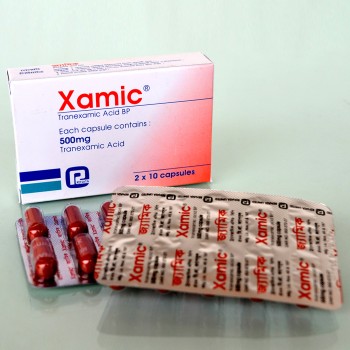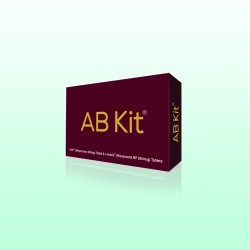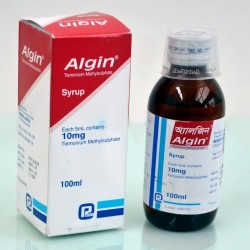Xamic 500mg Capsule 20's pack

Xamic 500mg Capsule 20's pack
৳ 301.00/=
Ex Tax: ৳ 301.00/=
- Stock: In Stock
- Model: MEDI-00074
- Generic: Tranexmic Acid 500mg
- Pack Size: Each pack contains 20 capsules of Xamic 500mg
0 items sold
4574 views
Available Options
Indications
Haemorrhage or risk of haemorrhage in increased fibrinolysis or fibrinogenolysis that may occur in conditions:
Hereditary angioneurotic oedema.
- Prostatectomy and bladder surgery
- Menorrhagia
- Epistaxis
- Conisation of the cervix
- Management of dental extraction in patients with coagulopathies
- Ulcerative colitis
- Haematuria
- Gastrointestinal haemorrhage
Hereditary angioneurotic oedema.
Therapeutic Class
Anti-fibrinolytic drugs, Haemostatic drugs
Pharmacology
PHARMACOLOGICAL ACTIONS: Tranexamic acid has a strong inhibitory effect on the activation of plasminogen, i.e. the conversion of plasminogen to plasmin, in the fibrinolytic system.The half life is 1-2 hours. Plasma protein binding is 3% at therapeutic plasma levels. The plasma protein binding seems fully accounted by its binding to plasminogen. Tranexamic acid is excreted unchanged in the urine.
PHARMACOKINETICS: Tranexamic acid is rapidly absorbed from the gastrointestinal tract. Maximum serum levels are reached within 2-3 hours. After oral administration, about 40% of the dose is excreted in the urine during the first 24 hours. After intravenous administration 45% of the dose is excreted in the urine during the first day.
PHARMACOKINETICS: Tranexamic acid is rapidly absorbed from the gastrointestinal tract. Maximum serum levels are reached within 2-3 hours. After oral administration, about 40% of the dose is excreted in the urine during the first 24 hours. After intravenous administration 45% of the dose is excreted in the urine during the first day.
Dosage & Administration
Intravenous administration is necessary only if it is difficult to give adequate doses by mouth. The recommended standard dose is 1 to 1.5 gm or 5-10 ml by slow intravenous injection at a rate of 1 ml/minute, two to three times daily. For the indications listed below the following doses are recommended.
PROSTATECTOMY: 5-10 ml by slow intravenous injection every eight hours (the first injection being given during the operation) for the first three days after surgery; thereafter 1-1.5 gm orally three to four times daily until macroscopic haematuria is no longer present.
MENORRHAGIA: 1-1.5 gm orally three to four times daily for three to four days.
EPISTAXIS: 1.5 gm orally three times daily for four to ten days. Tranexamic Acid injection may be applied topically to the nasal mucosa of patients suffering from epistaxis. This can be done by soaking a gauze strip in the solution, and then packing the nasal cavity.
HAEMATURIA: 1-1.5 gm orally 2-3 times daily until macroscopic haematuria is no longer present.
CONISATION OF THE CERVIX: 1.5 gm orally 3 times a day for 12 to 14 days post-operatively.
DENTAL SURGERY IN PATIENTS WITH COAGULOPATHIES: Immediately before surgery, 10 mg per kg body-weight should be given intravenously. After surgery, 25 mg per kg body-weight are given orally three to four times daily for six to eight days. Coagulation factor concentrate might be necessary to administrate.
GENERAL FIBRINOLYSIS: 1 gm by slow intravenous injection three to four times daily. With fibrinolysis in conjunction with diagnosed, increased intravascular coagulation i.e. defibrillation syndrome, an anticoagulant such as heparin may be given with caution.
HEREDITARY ANGIONEUROTIC OEDEMA: 1-1.5 gm orally two to three times daily as intermittent or continuous treatment depending on whether the patient has prodromal symptoms or not.
CHILDREN:
PROSTATECTOMY: 5-10 ml by slow intravenous injection every eight hours (the first injection being given during the operation) for the first three days after surgery; thereafter 1-1.5 gm orally three to four times daily until macroscopic haematuria is no longer present.
MENORRHAGIA: 1-1.5 gm orally three to four times daily for three to four days.
EPISTAXIS: 1.5 gm orally three times daily for four to ten days. Tranexamic Acid injection may be applied topically to the nasal mucosa of patients suffering from epistaxis. This can be done by soaking a gauze strip in the solution, and then packing the nasal cavity.
HAEMATURIA: 1-1.5 gm orally 2-3 times daily until macroscopic haematuria is no longer present.
CONISATION OF THE CERVIX: 1.5 gm orally 3 times a day for 12 to 14 days post-operatively.
DENTAL SURGERY IN PATIENTS WITH COAGULOPATHIES: Immediately before surgery, 10 mg per kg body-weight should be given intravenously. After surgery, 25 mg per kg body-weight are given orally three to four times daily for six to eight days. Coagulation factor concentrate might be necessary to administrate.
GENERAL FIBRINOLYSIS: 1 gm by slow intravenous injection three to four times daily. With fibrinolysis in conjunction with diagnosed, increased intravascular coagulation i.e. defibrillation syndrome, an anticoagulant such as heparin may be given with caution.
HEREDITARY ANGIONEUROTIC OEDEMA: 1-1.5 gm orally two to three times daily as intermittent or continuous treatment depending on whether the patient has prodromal symptoms or not.
CHILDREN:
- Oral dose: 25 mg/kg 2 to 3 times daily for 7 to 10 days.
- Injection: 10 mg/kg 6 to 8 hours for 7 to 10 days
Interaction
Clinically important interactions have not been observed with Tranexamic acid. Because of the absence of interaction studies, simultaneous treatment with anticoagulants must take place under the strict supervision of a physician experienced in this field.
Contraindications
- Active thromboembolic disease, such as deep vein thrombosis, pulmonary embolism and cerebral thrombosis
- Subarachnoid haemorrhage
- Hypersensitivity to Tranexamic acid or any of the ingredients
Side Effects
Dose-dependent, gastrointestinal discomfort is the most commonly reported undesirable effect, but it is usually of mild and temporary in nature. Allergic skin reactions have been reported as an uncommon undesirable effect. Hypotension may occur after fast injection.
Pregnancy & Lactation
Pregnancy: Tranexamic acid crosses the placenta. Clinical experience of use in pregnant women is limited. Animal studies have not supplied any evidence of an increased incidence of fetal damage.
Lactation: Tranexamic acid is excreted into breast milk, but it is not likely to influence the child at therapeutic doses.
Lactation: Tranexamic acid is excreted into breast milk, but it is not likely to influence the child at therapeutic doses.
Precautions
Patients with irregular menstrual bleeding, patients with a high risk of thrombosis (a previous thromboembolic event and a family history of thromboembolic disease) should use it only if there is a strong medical indication and under strict medical supervision.
Patients with disseminated intravascular coagulation (DIC), who require treatment with it must be under the strict supervision of a physician experienced in treating this disorder.
In the long-term treatment of patients, regular eye examination should be performed. If a colour vision disorder should occur during the course of treatment, the drug should be discontinued.
Patients with disseminated intravascular coagulation (DIC), who require treatment with it must be under the strict supervision of a physician experienced in treating this disorder.
In the long-term treatment of patients, regular eye examination should be performed. If a colour vision disorder should occur during the course of treatment, the drug should be discontinued.
Overdose Effects
Symptoms: Nausea, vomiting, dizziness, and headache.
Treatment of overdose: If justified, initiate vomiting, then gastric lavage, charcoal therapy, and symptomatic treatment. Maintain adequate diuresis.
Treatment of overdose: If justified, initiate vomiting, then gastric lavage, charcoal therapy, and symptomatic treatment. Maintain adequate diuresis.
Use in Special Population
Renal Impairment:
Intravenous: Adjust dose based on the serum-creatinine concentration:- 120-250 micromol/l: 10 mg/kg bid daily;
- 250-500 micromoles/l: 10 mg/kg once daily;
- >500 micromol/l: 5 mg/kg once daily or 10 mg/kg once every 48 hr.
- 120-250 micromol/l: 15 mg/kg bid daily;
- 250-500 micromol/l: 15 mg/kg once daily;
- >500 micromol/l: 7.5 mg/kg once daily or 15 mg/kg once every 48 hr.
Geriatric Use: Clinical studies of Tranexamic acid did not include sufficient numbers of subjects aged 65 and over to determine whether they respond different y from younger subjects. Other reported clinical experien e has not identified differences in responses between the elderly and younger patients. In general, dose selection for an elderly patient should be cautious, usually starting at the low end of the dosing range, reflecting the greater frequency of decreased hepatic, renal, or cardiac function, and of concomitant disease or other drug therapy. This drug is known to be substantially excreted by the kidney, and the risk of toxic reactions to this drug may be greater in patients with impaired renal function. Because elderly patients are more likely to have decreased renal function, care should be taken in dose selection, and it may be useful to monitor renal function. Drug Interaction Tranexamic Acid is known to interact with other drugs like Factor VIII. These interactions are sometimes beneficial and sometimes may pose threats to life. Always consult your physician for the change of dose regimen or an alternative drug of choice that may strictly be required. Pharmaceutical Precaution Keep in a cool & dry place, protected from light. Keep out of the reach of children.
Storage Conditions
Store at a cool and dry place, protected from light and moisture.
Source: medex.com.bd
Tags:
Xamic
, Tranexmic Acid
, Trexam
, Haemorrhage
, Prostetectomy
, Tooth Extraction
, Haemophilia
, Menorrhagia
, Hereditary Angiooedema
, Streptokinese overdose












